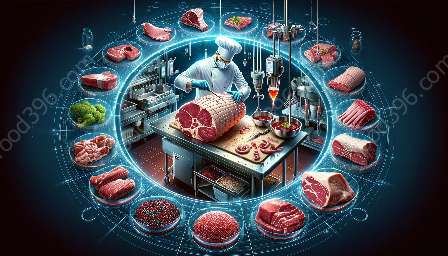Bacterial contamination in meat is a critical concern for meat safety, hygiene, and meat science. Understanding the causes, prevention, and regulations surrounding this issue is essential for ensuring the quality and safety of meat products.
Causes of Bacterial Contamination in Meat
Bacterial contamination in meat can occur at various stages of the meat production process. From the farm to the processing plant, meat is susceptible to contamination from pathogenic bacteria such as Salmonella, E. coli, and Listeria. These bacteria can be present on the surfaces of animals, equipment, and facilities, leading to the potential spread of contamination.
Improper handling and storage of meat products can also contribute to bacterial contamination. Cross-contamination, inadequate refrigeration, and inadequate cooking temperatures can promote the growth of bacteria in meat, further increasing the risk of contamination.
Impact on Meat Safety and Hygiene
The presence of pathogenic bacteria in meat poses a significant risk to public health. Consumption of contaminated meat can lead to foodborne illnesses such as Salmonellosis, E. coli infection, and Listeriosis, which can result in severe gastrointestinal symptoms and, in some cases, life-threatening complications.
Ensuring meat safety and hygiene is crucial for preventing the spread of bacterial contamination and reducing the risk of foodborne illnesses. Proper sanitation practices, temperature control, and adherence to food safety regulations are essential for protecting consumers from the harmful effects of bacterial contamination in meat.
Meat Science and Bacterial Contamination
Meat science plays a vital role in understanding the microbiological aspects of bacterial contamination in meat. Researchers and industry professionals analyze the behavior of bacteria in meat products, studying their growth patterns, resistance to antimicrobial treatments, and the development of innovative strategies to control contamination.
Advancements in meat science have led to the implementation of interventions such as hurdle technology, antimicrobial treatments, and packaging innovations that aim to mitigate bacterial contamination in meat and enhance its safety and quality.
Prevention and Control of Bacterial Contamination
Preventing bacterial contamination in meat requires a multifaceted approach that involves primary production practices, processing methods, and consumer education. Implementing good agricultural practices on farms, maintaining strict hygiene standards in processing facilities, and educating consumers about safe handling and cooking of meat are essential components of prevention.
The use of sanitizers, refrigeration, and proper cooking techniques are critical for controlling bacterial contamination and minimizing the risk of foodborne illnesses associated with meat consumption. Additionally, regulatory bodies play a crucial role in establishing and enforcing standards for microbial safety in meat production and distribution.
Regulatory Framework for Bacterial Contamination
Regulatory agencies such as the USDA (United States Department of Agriculture) and FDA (Food and Drug Administration) have established specific guidelines and standards for bacterial contamination in meat products. These regulations encompass microbial testing, labeling requirements, and the approval of antimicrobial interventions to ensure the safety of meat for consumers.
Adherence to these regulations is essential for meat producers and processors to maintain compliance and uphold the integrity of the meat supply chain. Regular inspections and monitoring by regulatory authorities help verify the implementation of proper sanitation, handling, and processing practices to prevent bacterial contamination in meat.
Conclusion
Bacterial contamination in meat poses significant challenges to meat safety, hygiene, and meat science. Understanding the causes, implementing effective prevention measures, and complying with regulatory standards are crucial for mitigating the risks associated with bacterial contamination in meat. By addressing this issue comprehensively, the meat industry can enhance the safety and quality of meat products, ultimately safeguarding consumer health and well-being.

